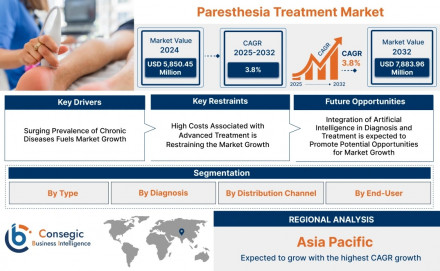Paresthesia Treatment Market: Application Segments and Demand Analysis (2025-2032)

Paresthesia Treatment Market Introduction:
Paresthesia refers to abnormal sensations such as tingling, prickling, or numbness typically felt in the hands, arms, legs, or feet, and sometimes in other parts of the body. These sensations are often associated with nerve damage or irritation and can be transient or chronic. The paresthesia treatment market comprises a range of therapeutic solutions including medications, physical therapy, nerve stimulation, and surgical interventions, targeted toward managing symptoms and treating underlying causes such as diabetic neuropathy, multiple sclerosis, spinal injuries, and nerve compression disorders. With rising neurological disorders and growing awareness about nerve health, the demand for paresthesia treatment is gaining significant traction.
Paresthesia Treatment Market Overview:
The paresthesia treatment market is witnessing steady growth driven by the increasing incidence of peripheral neuropathy, spinal disorders, and chronic conditions such as diabetes and multiple sclerosis. The market encompasses pharmaceutical interventions, including anticonvulsants, antidepressants, and pain relievers, as well as medical devices like spinal cord stimulators and nerve stimulators. Healthcare advancements, coupled with the rising geriatric population prone to neurological issues, are expanding the scope of treatment options. The integration of minimally invasive procedures and personalized medicine is also reshaping the landscape of paresthesia care. The market is fragmented with the presence of several global and regional players offering diverse treatment solutions.
Paresthesia Treatment Market Size:
Paresthesia Treatment Market size is estimated to reach over USD 7,883.96 Million by 2032 from a value of USD 5,850.45 Million in 2024 and is projected to grow by USD 5,968.52 Million in 2025, growing at a CAGR of 3.8% from 2025 to 2032.
Paresthesia Treatment Market Includes Drivers, Restraints & Opportunities
Drivers:
- Rising Prevalence of Chronic Diseases: The growing burden of diabetes, cancer, and multiple sclerosis significantly contributes to the rising number of patients experiencing paresthesia.
- Technological Advancements: Innovations in neuromodulation devices such as spinal cord stimulators and peripheral nerve stimulators enhance treatment efficacy and patient compliance.
- Growing Geriatric Population: Older adults are more susceptible to neuropathic conditions, thus driving the demand for paresthesia treatment.
- Increased Healthcare Access and Awareness: Improved access to healthcare services in emerging economies and rising awareness about nerve health are supporting market expansion.
- Research and Development: Pharmaceutical companies are actively investing in developing novel therapeutics targeting nerve disorders, further boosting the market.
Restraints:
- High Cost of Advanced Treatments: Devices like spinal cord stimulators are expensive, limiting their accessibility, particularly in low-income regions.
- Side Effects and Limitations of Medications: Commonly used drugs like anticonvulsants and antidepressants can have adverse effects, which may hinder long-term adherence.
- Complexity of Diagnosis and Treatment: The underlying causes of paresthesia vary greatly, making diagnosis and effective treatment challenging.
- Limited Awareness in Developing Regions: Despite growing prevalence, awareness about paresthesia and its treatment remains low in many parts of Asia and Africa.
Opportunities:
- Expansion in Emerging Markets: Rising healthcare infrastructure and government support in regions like Asia-Pacific and Latin America offer untapped growth potential.
- Integration of Digital Health Solutions: The use of telehealth and wearable devices for monitoring neurological symptoms is creating new avenues for personalized care.
- Product Innovation and Approvals: Development of new drug formulations and next-generation neuromodulation devices are creating competitive differentiation.
- Collaborations and Strategic Alliances: Partnerships between biotech firms and medical device companies can accelerate the development of integrated treatment solutions.
Paresthesia Treatment Market Competitive Landscape Analysis (Key Players)
- Pfizer Inc. (United States)
- Eli Lilly and Co. (United States)
- Mylan N.V. (United States)
- GlaxoSmithKline plc (United Kingdom)
- Johnson & Johnson (United States)
- Bristol-Myers Squibb (United States)
- Sanofi S.A. (France)
- AstraZeneca PLC (United Kingdom)
- Teva Pharmaceutical Industries Ltd. (Israel)
- Novartis International AG (Switzerland)
Paresthesia Treatment Market Industry Segmentation:
By Type
- Chronic paresthesia
- Temporary paresthesia
By Diagnosis
- Imaging tests
- MRI
- CT scan
- Electromyography (EMG)
- Blood tests
- Others
By Distribution Channel
- Hospital pharmacies
- Retail pharmacies
- Online pharmacies
By End-User
- Hospitals
- Specialty clinics
- Ambulatory surgery centers
- Home care settings
By Region
- Asia-Pacific
- Europe
- North America
- Latin America
- Middle East & Africa
Regional Analysis of the Paresthesia Treatment Market:
- North America dominates the global paresthesia treatment market owing to high healthcare spending, well-established medical infrastructure, and strong R&D investments. The U.S. leads due to high awareness and availability of advanced treatments.
- Europe holds a substantial share with key contributions from countries like Germany, the UK, and France. Favorable reimbursement policies and rising cases of chronic neurological conditions support market growth.
- Asia-Pacific is expected to exhibit the fastest growth during the forecast period, driven by increasing healthcare investments, growing elderly population, and rapid urbanization in countries like China, India, and Japan.
- Latin America and Middle East & Africa are witnessing gradual growth with rising awareness and improving access to medical technologies. However, challenges related to affordability and infrastructure remain.
Paresthesia Treatment Market Recent Developments:
- 2024: Boston Scientific launched its next-generation spinal cord stimulation system, featuring Bluetooth connectivity and enhanced patient programming.
- 2023: Abbott received FDA approval for expanded indications of its Proclaim XR spinal cord stimulator system.
- 2023: NeuroMetrix introduced Quell 2.0, an advanced wearable neuromodulation device for chronic pain and paresthesia management.
- 2022: Pfizer and Eli Lilly expanded their pain management drug portfolio with new clinical trial data for their nerve pain medication.
- Strategic Collaborations: Companies are entering strategic alliances to integrate AI-based monitoring with nerve stimulation therapies.
Contact us:
Consegic Business intelligence Pvt Ltd.
Contact no: (US) (505) 715-4344
Email: sales@consegicbusinessintelligence.com

